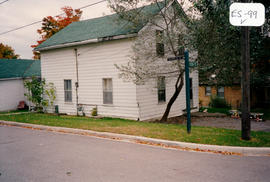- CA BWGPL GJ-HB-2017-04-05-02
- Item
- 1995
Part of George Jackson fonds
The structure located at 98 John St. East was the home of the Collings family years ago. The large, two-storey, frame and stucco-clad house has a long shed at the back that was once used for automobile storage (and later as a utilities room). Before World War II, there was a small building used for repairs and a blacksmith shop located east of the house. Along the lane fence at the south end of the property was a large, one-storey building used for storing marsh hay. South of the main house was a cement sidewalk that led to Holland Street. There was a garden (and later, grass) on each side of the house. Originally, the family owned a horse stable located at 100 John St. East.
Bill Peters and his wife were housekeepers for Ernie Collings Sr. when he lived here around 1907. Ernie owned marshland on the west side of the Holland River at the 10th Line. Years later the house was bought by James Armstrong and his wife Jane (Saint). Jim was a marsh hay worker and he owned land above the 10th Line on the west side of the river. Jim was an implement sales man on Holland Street (around the time of WWII) after marsh haying was finished. He also ran a garage at 11 Holland St East with Fred Gregory after Dennis Nolan closed his garage. Jim and Jane raised their daughters in this house. Daughter Shirley and her husband Bill Watson remained in the house after Jim and Jane died, but it was eventually sold. (1, 2)
George Jackson



